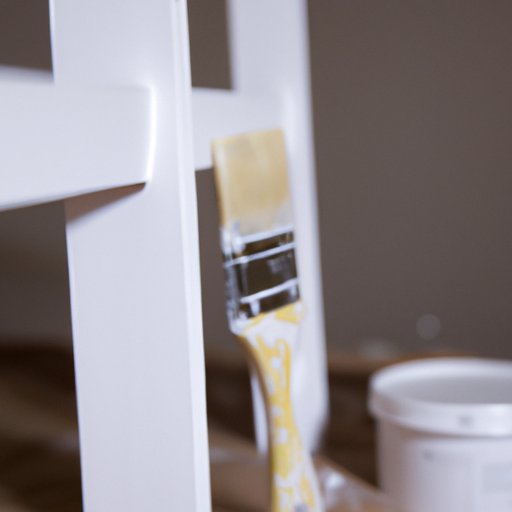Introduction
Painting cabinets white is a great way to brighten up a kitchen or bathroom. Even if you don’t have a lot of experience with painting, it’s possible to achieve excellent results with the right materials and techniques. In this article, we’ll cover everything you need to know about painting cabinets white, including an overview of the process, selecting the right paint and primer, applying the primer and paint, finishing touches and sealing, and troubleshooting common issues.
Preparing the Cabinets for Painting
The first step in painting cabinets white is to prepare the surfaces. This includes removing all hardware such as handles and knobs, as well as cleaning the surfaces with soap and water. Once the surfaces are clean and dry, use sandpaper to lightly sand any rough areas, and fill in any gaps or holes with wood filler. Make sure to let the filler dry completely before moving on to the next step.

Choosing the Right Paint and Primer
The type of paint and primer you choose can make a big difference in the outcome of your project. When selecting paint, look for one that is specifically designed for cabinets, as these will provide the best results. As for primer, choose one that is oil-based and designed for high-traffic areas. Both the paint and primer should be rated for interior use.
Applying the Primer
When applying primer, it’s important to take safety precautions such as wearing a mask and using proper ventilation. Start by pouring the primer into a paint tray and using a brush to apply an even coat to the cabinets. Be sure to follow the manufacturer’s instructions for drying times between coats.
Applying the Paint
Once the primer is dry, it’s time to apply the paint. Again, start by pouring the paint into a paint tray and use a brush to apply an even coat to the cabinets. Choose a brush that is specifically designed for cabinet painting, as these will provide the best results. Be sure to follow the manufacturer’s instructions for drying times between coats.
Finishing Touches and Sealing
Once the paint has been applied, it’s time to add any decorative touches. This could include adding new hardware or trim pieces. Once you’re satisfied with the look, it’s important to seal the finish with a clear topcoat. This will help protect the paint and keep it looking fresh for years to come.

Troubleshooting Common Issues with Painting Cabinets White
No matter how experienced you are with painting, there may be times when you encounter issues. Common issues include streaks and blotches in the paint, or paint that won’t stick to the surface. If you find yourself dealing with either of these issues, the best thing to do is to start over. Sand down the surface and reapply the primer and paint, taking extra care to make sure that you are applying even coats.
Conclusion
Painting cabinets white can be a great way to update the look of your kitchen or bathroom. By following the steps outlined in this article, you can achieve professional-looking results. The key is to take your time and use the right materials and techniques. With the right preparation and attention to detail, you can create beautiful, long-lasting results.


